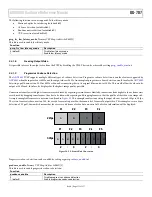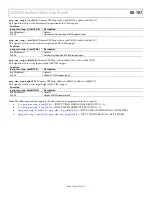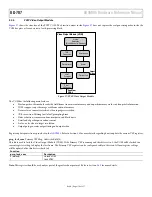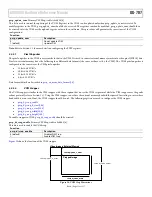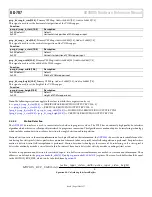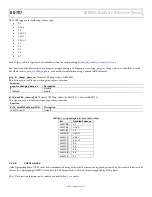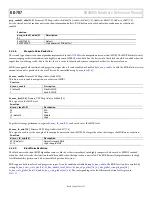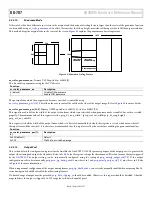
UG-707
ADV8005 Hardware Reference Manual
Rev. A | Page 126 of 317
di_bnr_detect_scale_line[3:0]
, Primary VSP 2 Map,
Address 0xE987[7:4]
This signal is used to configure the BNR processing ability.
Function
di_bnr_detect_scale_line[3:0] Description
0111 (default)
Recommended setting for low/mid level BNR
1001
Recommended setting for high level BNR
3.2.3.10.
Sharpness Enhancement
The sharpness enhancement block extracts high frequency data from the de-interlaced and de-noised video frame to help simultaneously
sharpen the appearance of edges and other video details, recover high frequency components and provide pictures with a natural look without
adding a halo or ringing artifact. Since the sharpness works on a two dimensional pixel array before the scaler, noise will not be scaled during
the scaling operation.
Detail and edge sharpness enhancement supports both interlaced and progressive inputs. It can be enabled or disabled using
. The sharpness level can be adjusted using the signed, twos complement value in
. To increase
the sharpness setting, the value in
should be increased. To decrease the sharpness setting, the value in
should be decreased.
di_sharpness_enable
, Primary VSP Map,
Address 0xE84C[7]
This bit is used to enable sharpness control.
Function
di_sharpness_enable Description
0 (default)
Disable sharpness
1 Enable
sharpness
pvsp_srscal_scale_gain[11:0]
, Primary VSP Map,
Address 0xE891[7:0]; Address 0xE892[7:4]
This signal is used to control the sharpness level.
Function
pvsp_srscal_scale_gain[11:0] Description
0x000 (default)
Sharpness level
3.2.3.11.
Scaler
The last block before the VOM output is the scaler which is used to scale the input video to the desired resolution. This is very flexible and can
support arbitrary resolution conversion and independently scale the input video horizontally and vertically. The ADI proprietary scaler
algorithms also allow improved performance in the scaling of the input video which improves many common issues associated with scaling
video data such as saw tooth, edge blurring, and ringing.
The
scaler employs contour-based interpolation techniques to provide sharp edges and crisp details on high resolution content. The
embedded compression noise reduction will eliminate mosquito noise and block artifacts. The contour-based interpolation scaler is capable of
upscaling input video formats from 480i to 4k x 2k formats (these include 4k x 2k 30 Hz/4k x 2k 25 Hz/4k x 2k 24 Hz and 4k x 2k 24 Hz SMPTE).
When the automatic scaler algorithm selection is enabled, the contour-based interpolation scaler is used for upscaling and downscaling is
performed using the frequency-adaptive scaler which implements the same algorithm as the VIM down scaler. A manual selection between
the contour-based interpolation scaler and the frequency-adaptive scaler is provided by
Also, because
provides 4kx2k timing in 8-bit precision,
is provided to make the entire scaler operate in 8-bit
mode. This lowers the power consumed by the scaler.


